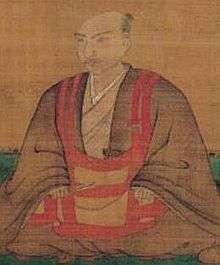Asakura Yoshikage
| Asakura Yoshikage 朝倉 義景 | |
|---|---|
 | |
| 5th Daimyo of the Asakura Domain | |
|
In office 1548–1573 | |
| Preceded by | Asakura Takakage |
| Succeeded by | None |
| Personal details | |
| Born | October 12, 1533 |
| Died | October 16, 1573 |
| Relations |
Father: Asakura Takakage Mother: Daughter of Takeda Motomitsu Wife: Daughter of Hosokawa Harumoto |
Asakura Yoshikage (朝倉 義景, October 12, 1533 – September 16, 1573) was a Japanese daimyo of the Sengoku period (1467–1573) who ruled a part of Echizen Province in present-day Fukui Prefecture. Yoshikage's conflicts with Oda Nobunaga (1534–1582) resulted in his death and the destruction of the Asakura clan and its castle, Ichijōdani Castle.[1][2][3]
Early career
Yoshikage was born at the Asakura clan castle in Echizen Province, Ichijōdani Castle, in the present-day Kidanouchi district of Fukui, Fukui Prefecture. His father was Asakura Takakage (1493–1548) and his mother is presumed to be the daughter of Takeda Motomitsu.[3] The Asakura had displaced the Shiba clan as the shugo military commanders of part of Echizen in 1471.[1] Yoshikage succeeded his father as head of the Asakura clan and castle lord of Ichijōdani Castle in 1548.[2][4] He proved to be adept at political and diplomatic management, markedly demonstrated by the Asakura negotiations with the Ikkō-ikki in Echizen. As a result of the negotiations and effective governance by Yoshikage, Echizen enjoyed a period of relative domestic stability compared to the rest of Sengoku era Japan. Consequently, Echizen became a site for refugees fleeing the violence in the Kansai region. Ichijōdani became a center of culture modeled on the capital at Kyōto.[1]
Conflicts with Oda Nobunaga
After the capture of Kyoto, Ashikaga Yoshiaki appointed Yoshikage regent and requested Asakura aid in driving Nobunaga out of the capital.[3] As a result, Oda Nobunaga launched an invasion of Echizen. Due to Yoshikage’s lack of military skill, Oda's forces were successful at the Siege of Kanegasaki (in modern-day Tsuruga city), leaving the entire Asakura Domain open to invasion.[1][5][6]
Yoshikage benefited from the military conflicts between Azai Nagamasa (1545–1573), brother-in-law of Oda Nobunaga. Azai had launched a pincer attack strategy against Nobunaga in Kanegasaki, but the coalition of Asakura and Azai forces failed in the task of capturing Nobunaga.[3] In the Battle of Anegawa in 1570, Yoshikaga and Nagamasa were defeated by the numerically superior Tokugawa clan headed by Tokugawa Ieyasu (1543–1616).[1]
Death
Yoshikage fled to Hiezan (Enryaku-ji, Hiei Monastery) after the Battle of Anegawa and negotiated a reconciliation with Nobunaga and was able to avoid conflict for three years.[3] Yoshikage was eventually betrayed by his cousin, Asakura Kageakira (1529–1574) in 1573. He was forced to commit suicide by seppuku at Rokubō Kenshō-ji, a temple which was located in present-day Ōno, Fukui Prefecture. He was 41 years old.[1][3] The Asakura clan was destroyed with the death of Yoshikage.[2]
Ichijōdani Asakura Family Historic Ruins
The former Asakura residence in Fukui Prefecture was excavated in 1967 and revealed the ruins of the castle, residences, and gardens of Ichijōdani. The site has been designated a Special Places of Scenic Beauty, Special Historic Sites, and an Important Cultural Properties of Japan as the Ichijōdani Asakura Family Historic Ruins. The site covers 278 hectares (690 acres).
References
- 1 2 3 4 5 6 "Asakura Yoshikage". Encyclopedia of Japan. Tokyo: Shogakukan. 2012. OCLC 56431036. Archived from the original on 2007-08-25. Retrieved 2012-08-22.
- 1 2 3 "朝倉 義景" [Asakura Yoshikage]. Nihon Jinmei Daijiten (日本人名大辞典) (in Japanese). Tokyo: Shogakukan. 2012. Archived from the original on 2007-08-25. Retrieved 2012-08-22.
- 1 2 3 4 5 6 "朝倉 義景" [Asakura Yoshikage]. Kokushi Daijiten (in Japanese). Tokyo: Shogakukan. 2012. OCLC 683276033. Archived from the original on 2007-08-25. Retrieved 2012-08-22.
- ↑ "朝倉 義景" [Asakura Yoshikage]. Nihon Kokugo Daijiten (in Japanese). Tokyo: Shogakukan. 2012. OCLC 56431036. Archived from the original on 2007-08-25. Retrieved 2012-08-22.
- ↑ "朝倉義景" [Asakura Yoshikage]. Dijitaru Daijisen (in Japanese). Tokyo: Shogakukan. 2012. OCLC 56431036. Archived from the original on 2007-08-25. Retrieved 2012-08-22.
- ↑ Turnbull, Stephen (1987). Battles of the Samurai. Arms and Armour Press. p. 60. ISBN 0853688265.